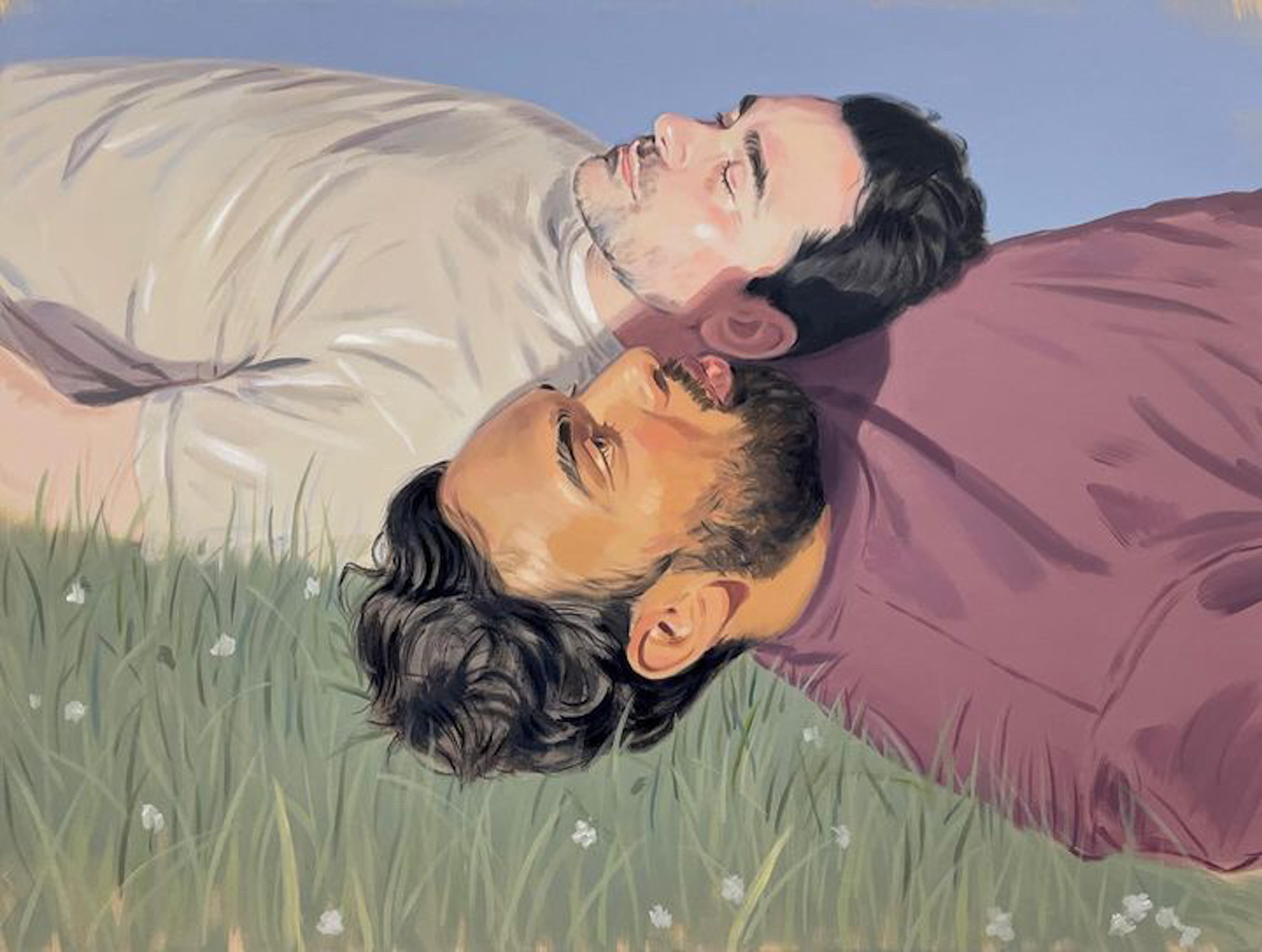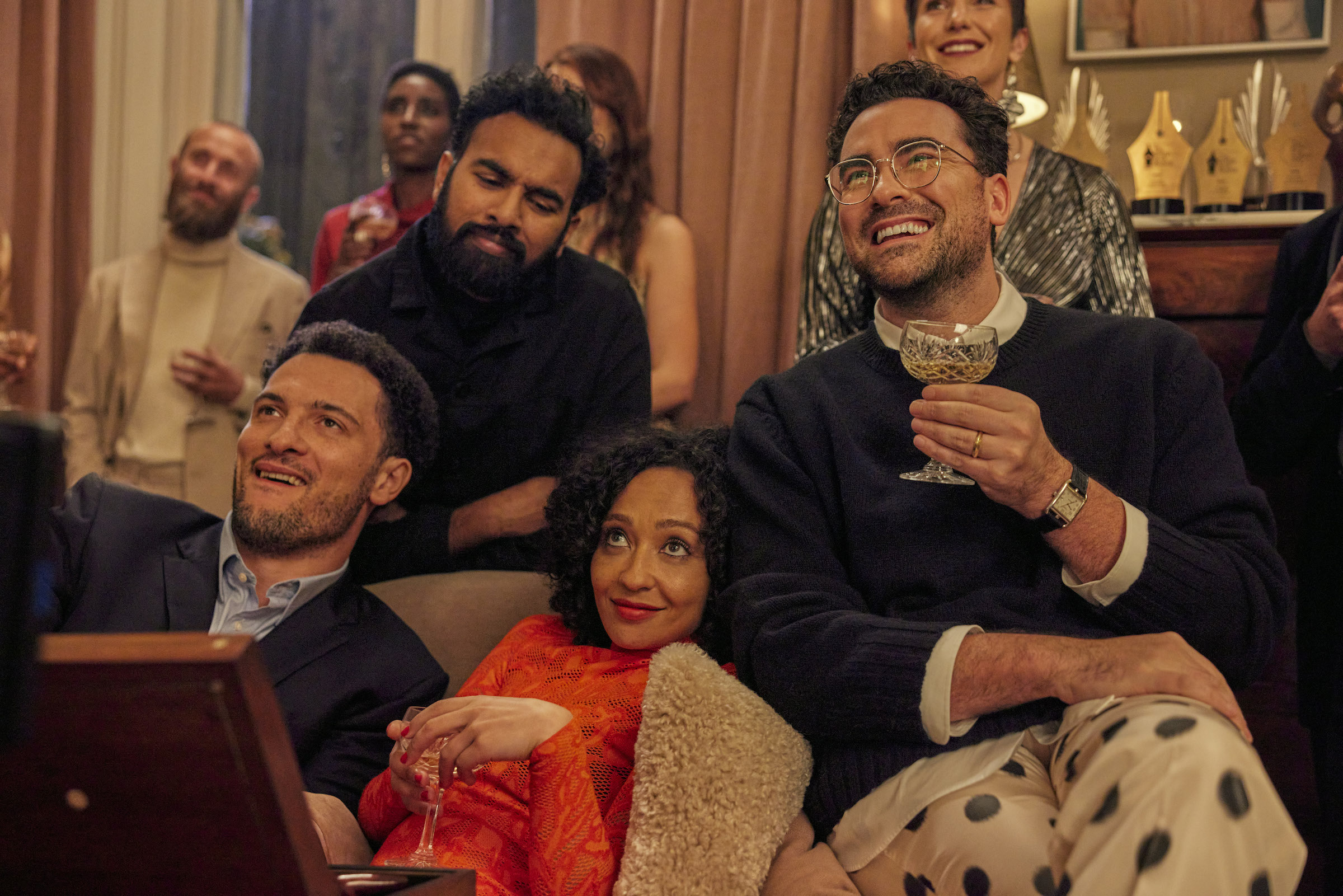
Art is the linchpin of Good Grief, a warm dramedy set in the heart of winter, out in theaters on Dec. 29 before coming to Netflix on Jan. 5. It’s a film that feels like snowfall: a gradual accumulation of a blanket of muted comfort. Dan Levy, who wrote, directed, and stars in the film, plays Marc, who is guided through grief by his best friends, Sophie (Ruth Negga) and Thomas (Himesh Patel) in the wake of his husband Oliver's (Luke Evans) death. An artist who used to paint, Marc finds his way back to the canvas as he heals.
The Marc we meet at the beginning of Good Grief is diminished—he stopped painting after his mom’s death, finding it too painful. Before Oliver died, Marc still made art, illustrating his husband’s books. But he shrank himself to magnify his husband. Now, he’s lost his partner. The people around him encourage him to pick up the paintbrush again.
We learn over the course of the film that Marc and Oliver’s marriage was far from perfect; Marc holds his complex emotions about Oliver’s death at arm’s length, watching them circle the drain, but never quite emptying the bath water. First Thomas, and then a lover, Theo (Arnaud Valois), nudge him toward art to help him heal.
“If you have the ability to write or to paint, sometimes that's all you can do,” Levy says in an interview. “It might not look like the sobbing, fall-down-the-wall, on-the-floor hysteria that we've come to equate with grief or with loss. And that's OK.”

Levy himself is not a painter. When he got the green light for the film, his first move was to solicit the help of one of his favorite artists, Kris Knight. Levy called Knight, whose work he’d been collecting for a decade, and asked him to be a shadow painter for his character.
They talked about their shared love for the 1998 Alfonso Cuarón movie Great Expectations, and its collaboration with a contemporary artist: Francesco Clemente painted for Ethan Hawke’s character, Finn. Knight was 18 when Great Expectations came out, and it inspired him to pursue art. Now it was his turn to paint the art that we see onscreen.
“It was important that the art stand out, that the portraits have a very distinct point of view,” Levy says. “The work had to reflect that emotionality, so that the audience can understand why he took a break from it and why he then would return to it.”
Knight’s work slots neatly into Marc’s character, interlocking like one had a notch carved for the other. Like Marc, Knight has illustrated book covers. (Most recently the forthcoming Henry Henry by Allen Bratton, a queer reimagining of Shakespeare's Henriad.) “His romantic paintings and portraits are simultaneously intimate as they are remote,” reads Knight’s website. “Halcyon queer moments have impact without being sensationalized.”

Knight tries to paint different modes of masculinity that he connects with, he says. He likes softness and darkness, and he loves humor and history. Melancholy seeps onto the canvas, as does most of what he absorbs, consciously or otherwise. Something similar happens for Marc in the film: He leaves the suffocating comfort of his home in London, where he lived with Oliver, to paint in the sharper, starker seaside of Kent.
“With my art, it comes from a queer lens, and I can't do anything about that, just because that's who I am,” Knight says. He interviews those who sit for his portraits, usually other queer creatives, and one of his main questions is about their coming out experience. It binds them together over generations and social and economic backgrounds.
Knight estimates that he made 15 to 17 pieces for the film, many of which are on display in a final, cathartic gallery scene.

“I connected with this story in terms of it being basically a new look on grief, and it's a queer lensing of grief,” Knight says. “And that's something I haven't seen in film before. Especially with the character dynamic of Oliver and Marc: I see that in straight film, and I see that in straight couples, where one partner kind of lives for the other.”
Knight and Levy both lost grandparents during the pandemic, a window of time that even further distorted our already slippery understanding of grief. For Levy, that grief spawned an onslaught of questions: “Is there an appropriate way to grieve? Why was I not feeling what I thought that I should feel? Was it enough?”
Good Grief airs those questions out loud, though it doesn’t necessarily answer them. “If it's not saying explicitly what you should do, I think it's a cautionary tale of what maybe you shouldn't,” Levy says. “To write Marc as an avoidant, it felt important, because I know so many people that choose the distraction over the confrontation.”
Good Grief is also, above all, a love letter to found family, to the friends who “help [detangle] that knot of feelings,” as Levy wrote in his director’s statement. In the movie, Thomas and Sophie buoy Marc with quiet acts of care, keeping him afloat. In Levy’s own life, he came out as gay to his friends first, unsure how the news would change the dynamic of his relationships with his family.

“My friendships are the great loves of my life,” Levy says. “And the idea of telling a story where the romance was the friendship felt really important to me.”
Toward the end of the movie comes a monologue from beloved British icon Celia Imrie, who plays Marc’s lawyer, Imelda. She’s helping Marc parse through Oliver’s will and offers him advice that, as he was writing the script, Levy felt was like an epiphany of sorts, a potential answer to his many questions.
“Physiology has a clever way of protecting us from what we perceive to be a threat to our bodies,” Imelda tells Marc, “which is why the more we close ourselves off, the less we feel.”
“And you can survive that way, until the usualness of it all starts creeping in, and the new life you’d built as a refuge begins to feel like a void,” she continues. “Because, as it turns out, to avoid sadness is also to avoid love.”
More Must-Reads From TIME
- The 100 Most Influential People of 2024
- Coco Gauff Is Playing for Herself Now
- Scenes From Pro-Palestinian Encampments Across U.S. Universities
- 6 Compliments That Land Every Time
- If You're Dating Right Now , You're Brave: Column
- The AI That Could Heal a Divided Internet
- Fallout Is a Brilliant Model for the Future of Video Game Adaptations
- Want Weekly Recs on What to Watch, Read, and More? Sign Up for Worth Your Time
Contact us at letters@time.com